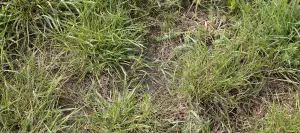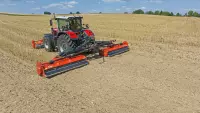Simply great forage - Minimum Level of Impurities
Considered here are all impurities which may be present in the forage: e.g. foreign bodies, soil, ensiled manure and plant residues, carcasses and mineral oil. All of these will have negative effects on the forage quality and therefore the farm´s profitability. The level of impurities must be kept to an absolute minimum. In practice, the discussion is dominated by the presence of soil in the forage.

Effects of soil on the forage
Crop contamination from soil is one of the most eminent problems for the quality of grass silages. In order to avoid poor fermentation and reduced feed values, producing forage with as little incorporated soil as possible is crucial.
High soil content:
- Deteriorates the ensilability due to an increased buffering capacity.
- Increases the danger of undesirable butyric acid fermentation because of elevated clostridia content.
- Reduces the energy content of the forage, because it is “diluted” with soil.
- Affects animal health and performance, as they can less easily digest the forage and will absorb fewer nutrients from it.

Soil contamination and energy content
The content of crude ash in the forage provides a good indication as to the level which the forage is contaminated with soil. Rising crude ash levels leads are synonymous with decreasing energy content. The figure below, depicting data of a grass silage after the first cut, shows this link very clearly. The strong decline of the energy concentration of the forage can be traced back to dilution effects as well as to energy-reducing faulty fermentation.
Crude ash and energy contents
It is important to remember that minimizing the soil content in forage is essential to achieving high feed values, and also pays off economically. The financial losses due to forage contamination may be considerable: the table below compares two grass silages, one with an acceptable soil content of approximately 2% and one with an increased soil content of approximately 4 % (see table).
Source: H. Nussbaum (2007): „Dreck macht nicht fett - Verschmutzung bei Grassilage“. Bildungs- und Wissenszentrum Aulendorf.

| Forage contamination / Soil content in the forage | |||
|---|---|---|---|
| 2% | 4% | ||
| Energy content silage | per kg DM | 6.3 MJ NEL | 6.1 MJ NEL |
| Energy content | per ha at yield of 10 t DM | 63,000 MJ NEL | 61,000 MJ NEL |
| Energy loss | per ha | 2,000 MJ NEL | |
| Value of energy losses* | 48 €/ha | ||
| Silage uptake | per cow and day | 13.0 kg TM | 12.5 kg TM |
| Silage uptake | per cow and year (200 days) | 2,600 kg TM | 2,500 kg TM |
| Energy uptake | per cow and year (200 days) | 16,380 MJ NEL | 15,250 MJ NEL |
| Reduction of energy uptake | 1,142 MJ NEL | ||
| Value of reduced silage uptake | per cow and year* | ca. 27 € | |
| Value of reduced silage uptake | per ha and year** | ca. 41 € | |
| Total effect | per ha and year | 89 € | |
* Compensated by concentrates,
** Stocking rate, 1.5 cows/ha
Source: Landwirtschaftskammer Niedersachsen 2014
Assuming a yield of 10 t DM/ha per year and a lower energy content of 0.2 MJ NEL/kg DM, the energy loss per ha per year add up to 2.000 MJ NEL for the silage with greater contamination. This represents approximately 48 €/ha per year, if compensated for with concentrates. Additional costs must also be considered as a lower energy content reduces the feed quality and therefore energy uptake. Summarizing the effects, losses of approximately 89 €/ha per year have to be budgeted.
How to achieve?
Approximately 10 % of crude ash in the dry matter is the limit for high forage quality*. This corresponds to a soil content of approximately 1-2 % in the dry matter – but how can such small percentages be achieved?
*Source: R. Resch (2008): „Grundfutterqualität - Bewertung der wichtigsten Einflüsse“. 5. Fachtagung für Schafhaltung, 1 – 7, LFL Raumberg-Gumpenstein.
Adequate protection of the sward
Adequate grassland care is the first step towards the production of high-quality forage with low soil content. Taking measures such as adapting intensity of use to a given site, levelling, rolling and re-seeding of appropriate varieties all help to ensure a high performance crop is produced which is able to form a thick sward. Complete coverage of the soil surface combined with a high percentage of grass in the mix facilitates a harvest with low soil content. Conversely, grassland with a light sward and many weeds increase the risk of forage contamination during harvest.

Combating pests such as moles and voles may also be necessary if they damage the grass stubble.
In order to protect the sward, soil compaction must also be avoided. It is therefore imperative that trafficking on the grassland only takes place in appropriate conditions when it is not too wet. The tyre size and pressure must also be properly set to combat compaction issues.
Ensure the correct cutting height
The choice of the right cutting height is essential for harvest success with only small amounts of soil in the forage. In general, forage should never be cut below the minimum height of 5-7 cm. Above this value, the cutting height has to be adapted to:
- The harvested crop,
- Perennial vs. non-perennial grassland (arable feed crop production),
- Grass stubble conditions.

There are numerous benefits to properly adapting the cutting height. The higher the stubble, the better the wilting of the cut grass, therefore improving the work quality of other machines in the harvest chain. This is because the cut grass is delivered as a layer on the stubble allowing it to sit above the soil surface. Moreover, a lower stubble height inhibits the regrowth of the grass and promotes the establishment of undesirable species.
Correct adjustment of harvest implements
All harvest implements (tedders, rakes, pick-ups of forage wagons /balers/forage harvesters etc.) must be properly adjusted to avoid the contact of the tines with the ground and therefore reduce as far as possible the incorporation of soil into the forage. The distance between the tines and the soil should be 3-4 cm minimum.
The driving speed should also be adapted to suit the field conditions (flat/undulating). This ensures that the implements can accurately follow the ground contours and prevent the tines from scratching the soil surface. Maximum driving speeds of approximately 5-7 km/h for tedding and 10-12 km/h for raking are recommended.
Other News

Shredding large areas is no problem!
The BP 8402 PRO is a versatile shredder that works a width of up to 8.40 metres, ideal for users looking for high work output.
Read
Focus on some of the 2025 highlights
2025 was a year of innovation and success. Here are some of the highlights.
Read
More innovations for wine growers, arborists, and landscape maintenance
Read